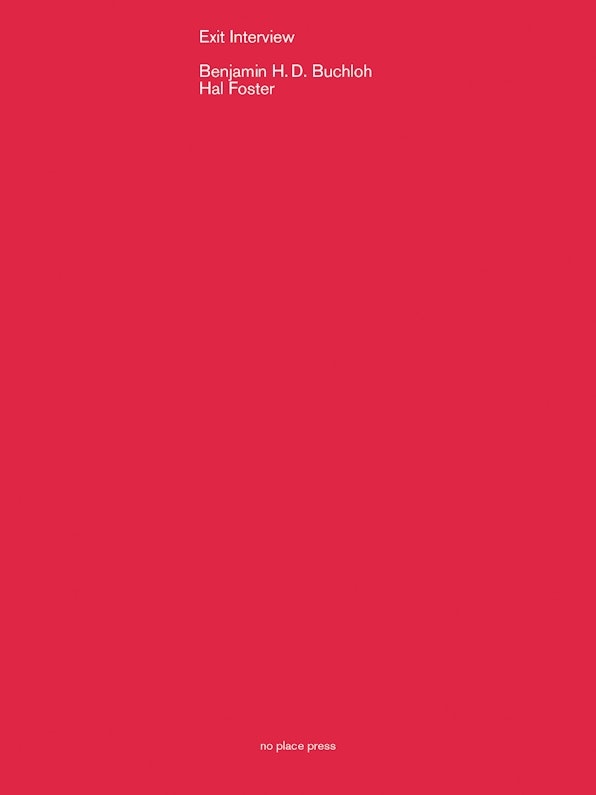News
April 10, 2024
Michael Asher featured in Exit Interview, forthcoming from no place press
Michael Asher Foundation is proud to have supported the completion of a new publication from no place press, Exit Interview. In Exit Interview, prominent art critics and historians Hal Foster and Benjamin H.D. Buchloh discuss their intellectual foundations and the projects they’ve worked on together, from October magazine to Art Since 1900. Through three conversations, Foster engages Buchloh on his early influences and aspirations, his formative years in Berlin, London, and Dusseldorf, and his career in North America, while exploring the impact of other art historians and critics. The book includes, among many other histories, discussion of Buchloh’s work with Michael Asher.
Artists Space in New York City will celebrate the book’s release on April 11th with a conversation between art historian Pamela M. Lee and the authors. For more information about this event click here.
For additional discussion of Asher by Buchloh, researchers may also be interested in the Foundation’s oral history interview with Buchloh, conducted by art writer Annette Leddy in April 2022. For more information or to request a transcript, please contact: assistant@
____
Michael Asher is one of the most significant artists associated with the emergence of conceptual art in the 1960s, a pivotal twentieth-century movement in which artists sought to reconsider and redefine the form, function, meaning, and display of a work of art. Often described as an artist engaged with institutional critique, his works drew attention to the formation and reception of artworks within institutional spaces and to the making of history.
Benjamin H.D. Buchloh, an art historian and critic, served as the Andrew W. Mellon Research Professor of Modern and Contemporary Art at Harvard University through 2021. He is the author of Gerhard Richter: Painting After the Subject of History (2022); Formalism and Historicity: Models and Methods in Twentieth-Century Art (2015); and Neo-Avantgarde and Culture Industry: Essays on European and American Art from 1955 to 1975. He was co-curator of the Gerhard Richter retrospective at the Metropolitan Museum/Met Breuer, New York in 2020. In 2007, Buchloh received the Golden Lion for Contemporary Art History and Criticism at the Venice Biennale.
Hal Foster is Townsend Martin, Class of 1917, Professor of Art and Archaeology at Princeton University. He was a founding editor of Zone Magazine and Zone Books and writes regularly for October (which he coedits), Artforum, and The London Review of Books. Recent books include What Comes After Farce? Art and Criticism at a Time of Debacle (2020); Conversations about Sculpture, with Richard Serra (2018); Bad New Days: Art, Criticism, Emergency (2015); and The First Pop Age: Painting and Subjectivity in the Art of Hamilton, Lichtenstein, Warhol, Richter, and Ruscha (2012).
Annette Leddy conducts oral histories for The Archives of American Art and the Michael Asher Foundation. She previously held the position of New York Collector for the Archives of American Art and before that was an archivist and curator at the Getty Research Institute. She has published numerous essays and reviews on modern and contemporary artists, and co-authored Farewell to Surrealism: the Dyn Circle in Mexico (Getty Research Institute, 2012).
Pamela M. Lee is Carnegie Professor of Modern and Contemporary Art in the Department of the History of Art at Yale University. She is the author of Think Tank Aesthetics: Midcentury Modernism, the Cold War and the Neoliberal Present (MIT Press, 2020). A co-editor of October, Lee is researching the concept of small wars and everyday militarism in contemporary art.
October 7, 2023
Jack Brogan and Michael Asher
The Foundation has begun collecting oral histories with individuals who were significant in relation to Michael Asher’s practice, including an interview with Jack Brogan, conducted by art writer
Annette Leddy.
Additionally, the Foundation is pleased to share the announcement for an upcoming talk at Dia Chelsea, Artists on Artists Lecture Series: Margaret Honda on Jack Brogan.
Margaret Honda on Jack Brogan
Wednesday, October 11, 2023, 6:30 pm
Dia Chelsea
537 West 22nd Street
New York, New York
Free. Register for the event here.
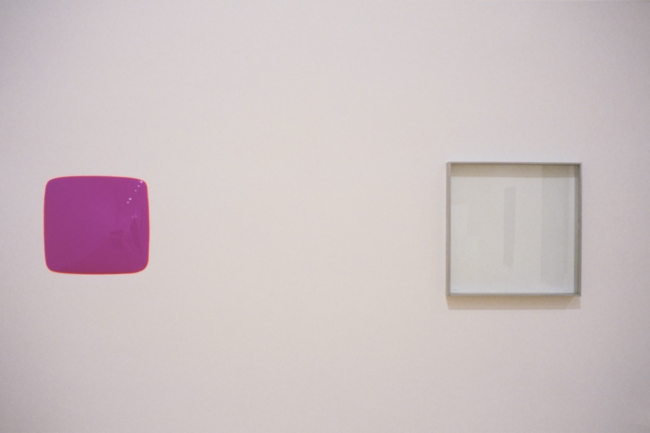 Michael Asher, Museum of Contemporary Art, Los Angeles, Los Angeles, California, USA, A Minimal Future? Art as Object 1958–1968, March 14–August 2, 2004, detail view of installation showing two works with no title by Michael Asher. Left: heat-formed Plexiglas (fluorescent pink), 1966; right: aluminum and glass, 1967. Courtesy of The Museum of Contemporary Art, Los Angeles. © Michael Asher Foundation.
Michael Asher, Museum of Contemporary Art, Los Angeles, Los Angeles, California, USA, A Minimal Future? Art as Object 1958–1968, March 14–August 2, 2004, detail view of installation showing two works with no title by Michael Asher. Left: heat-formed Plexiglas (fluorescent pink), 1966; right: aluminum and glass, 1967. Courtesy of The Museum of Contemporary Art, Los Angeles. © Michael Asher Foundation.
In her lecture, Margaret Honda will elucidate the significant role of the late Jack Brogan as a fabricator who collaborated with key figures in the history of Minimal, Postminimal, and Conceptual art, including Michael Asher, Lynda Benglis, and artists in the Dia collection such as Larry Bell and Robert Irwin. Shedding light on Brogan’s practice and the ways it has influenced her own artistic development, Honda will demystify the invisible labor and histories within art production since the 1960s.
____
In Fall 2022, the simultaneously legendary yet under-recognized art fabricator Jack Brogan (b. 1930) passed away at the age of 92. Known for producing works with and for Michael Asher, Robert Irwin, Helen Pashgian, Peter Alexander, Lynda Benglis (the list goes on…) as well as later restoring and repairing works by some of the 21st century’s most significant artists (Alexander Calder, Ellsworth Kelly, and more), Brogan was the alchemist—as Lawrence Weschler describes him—architect, and engineer behind the “Finish Fetishists,” expertly employing industrial processes and technology to produce fine art.
After meeting in LA in the 1960s, when Brogan’s studio was in Venice, CA, near Asher’s apartment, Brogan worked with Michael Asher to realize some of his earliest works, such as his early heat-formed Plexiglas pieces, pictured above and below.
Asher is well known for his site-specific projects, which typically existed only for the duration of the exhibition and often altered the existing environment by repositioning or removing material elements of the space or by making interventions based on his research about the institution. Lesser known are his early works, which exist as stand-alone objects that circulate in the world. In these works, we can see Asher interrogate painting and sculpture—and object-making in general—in relation to architecture in ways that anticipate his later shift to site-specificity and institutional critique.
In January and February 2022, art writer Annette Leddy interviewed the technical artist, fabricator, and conservator Jack Brogan in Los Angeles, California. To date Michael Asher Foundation has collected oral histories with Jack Brogan, Benjamin Buchloh and Claire Copley. For more information or to request a transcript, please contact: assistant@
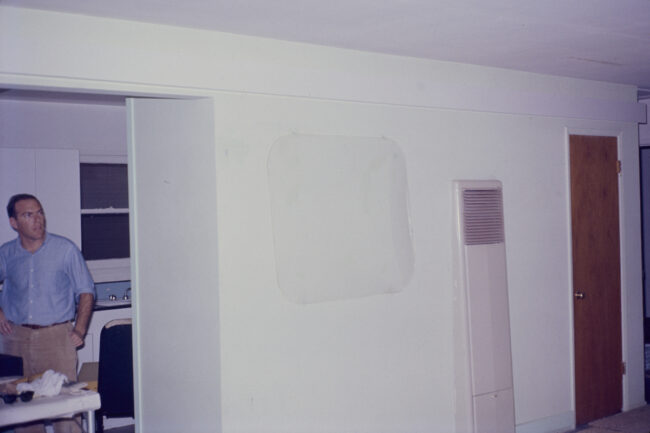 Michael Asher in his apartment in 1966. A heat-molded Plexiglas work is installed on the wall in the foreground. Image digitized from a 35 mm color slide in the Michael Asher Archive. © Michael Asher Foundation.
Michael Asher in his apartment in 1966. A heat-molded Plexiglas work is installed on the wall in the foreground. Image digitized from a 35 mm color slide in the Michael Asher Archive. © Michael Asher Foundation.
Michael Asher is one of the most significant artists associated with the emergence of conceptual art in the 1960s, a pivotal twentieth-century movement in which artists sought to reconsider and redefine the form, function, meaning, and display of a work of art. Often described as an artist engaged with institutional critique, his works drew attention to the formation and reception of artworks within institutional spaces and to the making of history.
Jack Brogan was a technical artist, fabricator, and conservator in Los Angeles, California. Born (in 1930) and raised in Tennessee, Brogan moved to Los Angeles in 1958, where he opened a cabinetmaking and furniture repair shop. In 1965 Brogan founded his business, Design Concepts, to address the varying material and production needs of the artists, architects, and industrial designers he worked with to fabricate prototypes and unique objects.
Margaret Honda was born in San Diego, California, in 1961. She works primarily in sculpture and film, with a focus on the malleability of materials and production protocols. Her work has been exhibited internationally at venues such as the Art Institute of Chicago; Carnegie Museum of Art, Pittsburgh; and KW Institute for Contemporary Art, Berlin. Her films have been shown at Anthology Film Archives, New York; Berlinale, Berlin; and Centre Pompidou, Paris. She lives in Los Angeles.
Annette Leddy conducts oral histories for The Archives of American Art and the Michael Asher Foundation. She previously held the position of New York Collector for the Archives of American Art and before that was an archivist and curator at the Getty Research Institute.
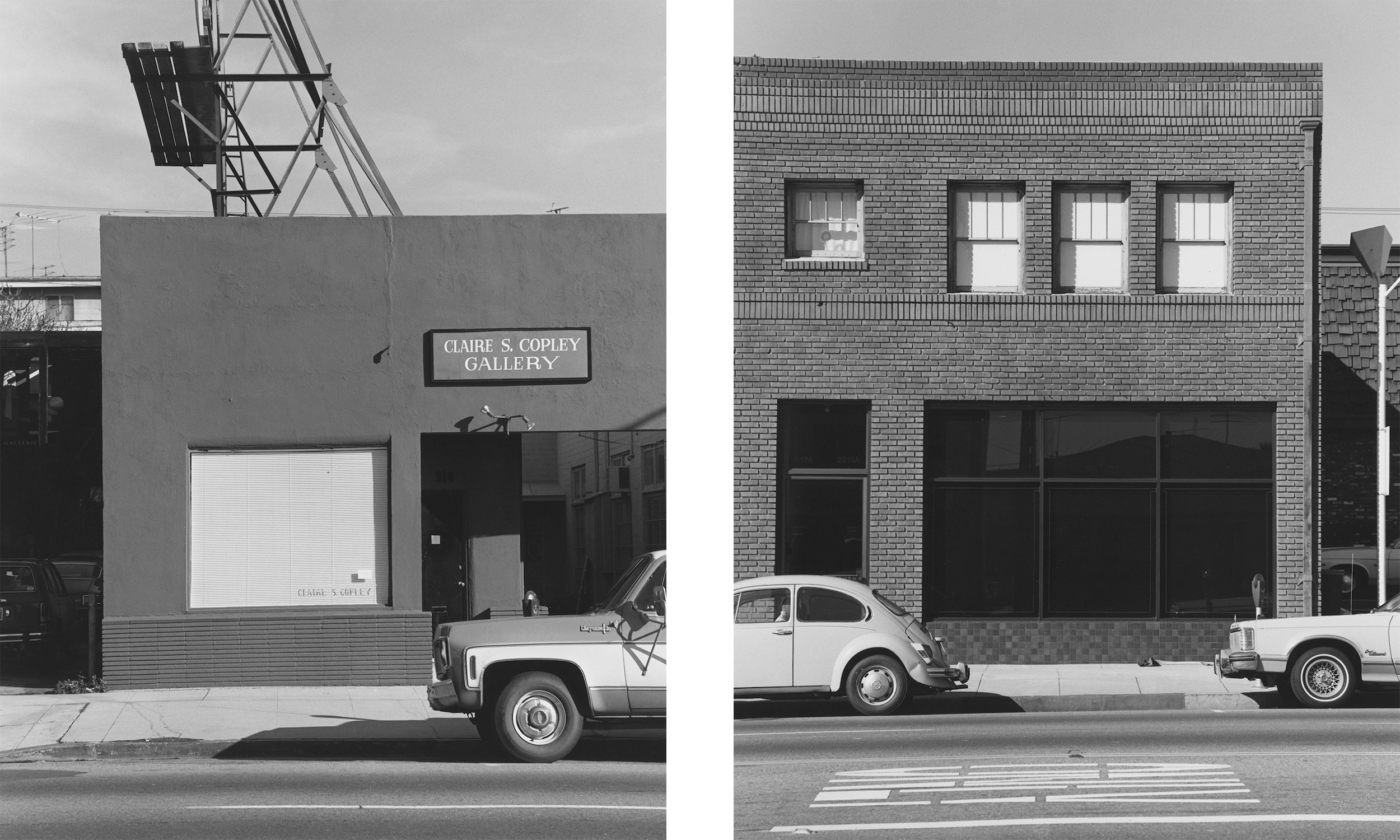 Michael Asher, Claire S. Copley Gallery, Los Angeles, California, and Morgan Thomas Gallery, Santa Monica, California, USA, February 8–25, 1977. Left: Facade of the Claire Copley Gallery on 918 North La Cienega Blvd., Los Angeles, CA. Right: Building on 2919 Santa Monica Blvd., Santa Monica, CA., where Morgan Thomas Gallery was located on the second floor. Photographs by Gary Krueger. © Michael Asher Foundation.
Michael Asher, Claire S. Copley Gallery, Los Angeles, California, and Morgan Thomas Gallery, Santa Monica, California, USA, February 8–25, 1977. Left: Facade of the Claire Copley Gallery on 918 North La Cienega Blvd., Los Angeles, CA. Right: Building on 2919 Santa Monica Blvd., Santa Monica, CA., where Morgan Thomas Gallery was located on the second floor. Photographs by Gary Krueger. © Michael Asher Foundation.
August 18, 2023
Oral History: Claire Copley on Michael Asher
The Foundation has begun collecting oral histories with individuals who were significant in relation to Michael Asher’s practice, including Claire Copley.
Claire Copley, owner and director of an eponymous gallery on La Cienega Boulevard, ushered in a cohort of artists pursuing bold new experiments at a time when contemporary art was not easy to see in Los Angeles. Throughout her gallery’s run, from 1973 to 1977, Copley exhibited the work of both American and European conceptual artists, including William Wegman, Allan McCollum, Allen Ruppersberg, Daniel Buren, Joseph Kosuth, Bas Jan Ader, and of course, Michael Asher. Though such a work was challenge to sell in a commercial gallery, history has shown that Copley’s taste was prescient and innovative—many of the artists she showed in her small gallery have gone on to have highly influential and celebrated careers.
The gallery was also the site where Michael Asher debuted what arguably remains one of his most well known works, which involved removing a wall that separated the gallery viewing room from the space’s back office to reveal the gallery’s daily inner workings.
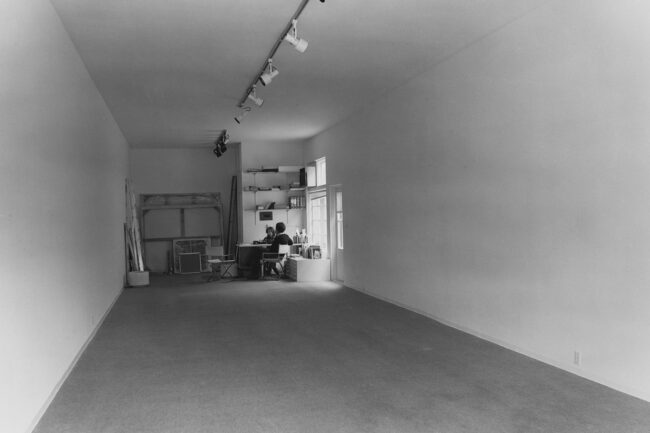 Michael Asher, Claire S. Copley Gallery, Los Angeles, California, USA, September 21–October 12, 1974, view through the gallery toward the office and storage areas. Photograph by Gary Krueger. © Michael Asher Foundation.
Michael Asher, Claire S. Copley Gallery, Los Angeles, California, USA, September 21–October 12, 1974, view through the gallery toward the office and storage areas. Photograph by Gary Krueger. © Michael Asher Foundation.
The removal of the wall has come to be emblematic of Asher’s practice, which often involved processes of subtraction, architectural interventions, and the redirection of the viewer’s attention to the material and conceptual conditions of the site.
In addition, Asher later conducted what was for Copley, an even riskier and more ambitious spatial and relational disruption, arranging for Copley and gallerist Morgan Thomas to swap shows—shows composed of works that were, importantly, not by Asher. Raising questions about what constituted the exhibition and the works therein, the project continued Asher’s scrutiny of the exhibition space and customs.
In the excerpt below, art writer Annette Leddy asks Claire Copley about Asher’s first project with her gallery:
Annette Leddy: But I’m wondering, so when you say he gave you a proposal, was it a typewritten—
Claire Copley: No, it was verbal.
AL: He just said, “Here’s what I want to do.”
CC: Right.
AL: “I want to take down the wall.”
CC: Right.
AL: Okay. And did he give you any explanation about it?
CC: He did. I mean, when he proposed it he explained that he thought by opening up the gallery, by opening up the office to the exhibition space, you really [would] focus on the business and the whole issue of the gallery. You know, what is it? What is the space without art? What does the office look like? What goes on in the office? What do I do every day? So I was really a goldfish in that sense. We talked a lot about that—what my role in this piece was. It was, in many ways, difficult to be an actor in this piece, because I was the thing that was on view.
AL: Yes, exactly.
CC: And it was kind of uncomfortable—although this piece was much less uncomfortable than the other piece.
AL: As I can imagine. So it was up for a month, is that correct?
CC: Mm-hmm.
AL: So for a month every day you would go to work, and you would not be the artwork, but essentially the focus of attention when people came in.
CC: Yes, it was interesting because people would hover at the door or—[pointing to diagram] this is all window here, and so they would hover outside or at the door and they would say, “I don’t want—I don’t think there’s a show up there, you know, I don’t think we should go in, there’s nothing there.” And so I would have to kind of get up and, you know, explain to people what was going on. And I did feel obligated to do that because there was really no other way for them to know.
AL: There was no wall text that explained it?
CC: No.
AL: Michael himself didn’t feel it would be his role to be there explaining it, so—
CC: No.
AL: So you were sort of put in that position of just showing them? And so then what would they do? Would they come in and then just stand there?
CC: Yes, I would, you know, try to get them inside, and then we would just talk about it, what it was and why, and so in that sense I was a translator for a lot of people. And while in some cases that was fun because it engendered really interesting conversations, other times, you know, it was tedious.
____
To date the Foundation has collected oral histories with Jack Brogan, Benjamin Buchloh and Claire Copley. For more information or to request transcripts, please contact: assistant@michaelasherfoundation.
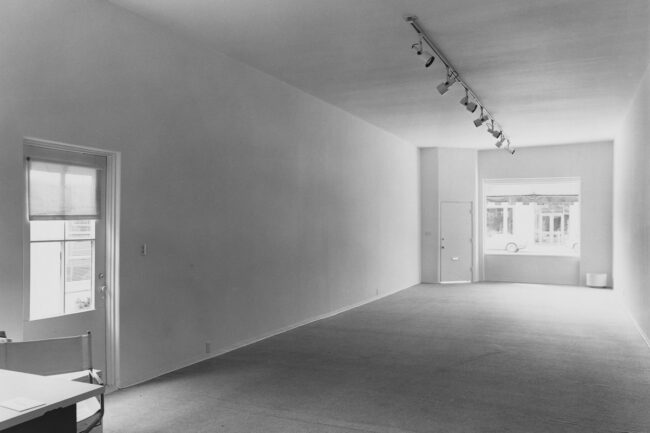 Michael Asher, Claire S. Copley Gallery, Los Angeles, California, USA, September 21–October 12, 1974, viewing through gallery towards entry/exit and street. Photograph by Gary Krueger. © Michael Asher Foundation.
Michael Asher, Claire S. Copley Gallery, Los Angeles, California, USA, September 21–October 12, 1974, viewing through gallery towards entry/exit and street. Photograph by Gary Krueger. © Michael Asher Foundation.
Annette Leddy conducts oral histories for The Archives of American Art and the Michael Asher Foundation. She previously held the position of New York Collector for the Archives of American Art and before that was an archivist and curator at the Getty Research Institute.
Claire Copley operated her eponymous gallery on La Cienega Boulevard in Los Angeles from 1973 to 1977. A defining institution of the LA art scene of the 1970s, the gallery established a reputation for showing American and European minimalist and conceptual artists, including Michael Asher. Following the gallery’s closure, Copley co-founded the nonprofit Foundation for Art Resources with fellow gallerists Morgan Thomas and Connie Lewallen.
Michael Asher is one of the most significant artists associated with the emergence of conceptual art in the 1960s, a pivotal twentieth-century movement in which artists sought to reconsider and redefine the form, function, meaning, and display of a work of art. Often described as an artist engaged with institutional critique, his works drew attention to the formation and reception of artworks within institutional spaces and to the making of history.
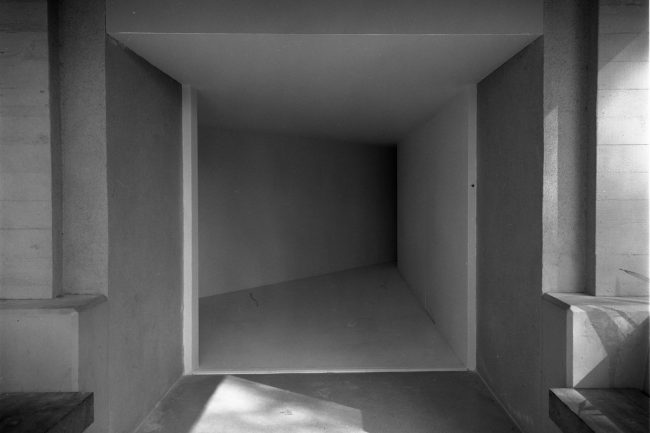
Gladys K. Montgomery Art Center, Pomona College, Claremont, California, USA, February 13–March 8, 1970, detail of entry/exit and view into constructed triangular area. Photo taken with daylight. Photograph by Frank J. Thomas, courtesy of the Frank J. Thomas Archive. © Michael Asher Foundation.
May 24, 2022
Michael Asher: There is Never Enough Time to Get Everything Said by Thomas Lawson
On the occasion of the new edition of Michael Asher’s Writings 1973-1983 on Works 1969-1979 published by Primary Information, Thomas Lawson, Dean of the School of Art at CalArts, artist, and Editor-in-Chief of East of Borneo, offers a reconsideration of Michael Asher’s work in a new essay for East of Borneo.
“Michael Asher’s work was ever as slippery as thought, inviting a sudden understanding, a new way of looking at something, and then gone. Asher generally conceived a work for a particular space and time; he would add or subtract something, change something, in the hope of increasing his viewers’ perception of that environment’s context, and perhaps also deepening their understanding of the conventions and structures that make contemporary art visible and meaningful.”
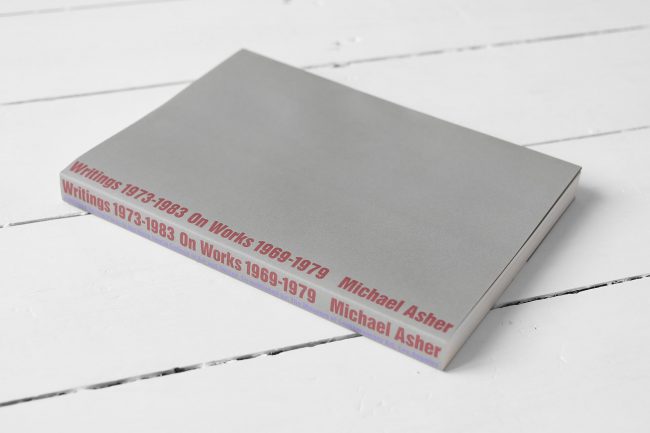
Photograph: Poppy Coles.
May 9, 2022
Virtual Panel Discussion on Writings 1973-1983 on Works 1969-1979
Please join us for an online discussion of Michael Asher’s Writings 1973-1983 on Works 1969-1979, hosted by Primary Information, the publisher of a new facsimile edition in October 2021. The panel will include the book’s editor Benjamin H.D. Buchloh alongside artists Andrea Fraser and Cameron Rowland. It will be moderated by Hamza Walker, Director of LAXART.
Writings 1973–1983 on Works 1969–1979 is an essential document of a decade of formative work by Michael Asher. Originally published in 1983, the book presents 33 works (plus an additional work from 1983–1985 inside the dust jacket) through the artist’s writings, photographic documentation, architectural floor plans, exhibition announcements, and other ephemera.
Initiated by Kasper König, Writings 1973-1983 on Works 1969-1979 was originally co-published by the Press of the Nova Scotia College of Art and Design and the Museum of Contemporary Art, Los Angeles, and was largely shaped by Asher’s close collaboration with Buchloh, who succeeded König as editor of the press in 1977.
Monday, May 9, 2022
3:30 PDT // 6:30 EDT
CLICK HERE TO RSVP
About the Participants
Benjamin H.D. Buchloh, an art historian and critic, is currently Andrew W. Mellon Research Professor at Harvard University, where he taught between 2005 and 2021 in the History of Art and Architecture department. He is the author of Neo-Avantgarde and Culture Industry: Essays on European and American Art from 1955 to 1975 and Formalism and Historicity: Models and Methods in Twentieth-Century Art, both of which were published by the MIT Press. His monograph on Gerhard Richter will be published by MIT Press in July 2022. In 2007, he received the Golden Lion for Contemporary Art History and Criticism at the Venice Biennale. From 1977 – 1985 he was Director of the Press at the Nova Scotia College of Art and Design, editing books on Michael Asher, Dara Birnbaum, Dan Graham, Jenny Holzer, Gerhard Richter, Martha Rosler, Allan Sekula, and Lawrence Weiner among others.
Andrea Fraser is an artist whose work investigates the social, financial, and affective economies of cultural institutions, fields, and groups. She is Professor at the UCLA Department of Art. Retrospectives of her work have been presented by the Museum Ludwig Cologne (2013), the Museum der Moderne Salzburg (2015), the Museum of Contemporary Art Barcelona, and MUAC UNAM Mexico City (both 2016). Her recent books include 2016 in Museums, Money, and Politics (2018, co-published by the CCA Wattis Institute, Westreich/Wagner Publications, and MIT Press) and Andrea Fraser Collected Interviews 1990-2018 (2019, A.R.T. Press and Koenig Books).
Cameron Rowland is an artist in New York. Rowland’s work relies on a materialist critique of racial capitalism, attending to institutions of subjection as well as their refusal. Their work has been exhibited in solo exhibitions at the Institute of Contemporary Arts, London; Museum of Contemporary Art, Los Angeles; Galerie Buchholz, Cologne, Germany; Établissement d’en face, Brussels; Kunsthalle Freiburg, Switzerland; Artists Space, New York; and Essex Street / Maxwell Graham, New York.
Hamza Walker is Director of LAXART, a nonprofit art space in Los Angeles, and an adjunct professor at the School of the Art Institute of Chicago. Prior to joining LAXART in 2016, he was director of education and associate curator at the Renaissance Society, a non-collecting contemporary art museum in Chicago. Recent exhibitions at LAXART include Kandis Williams/Cassandra Press’ The Absolute Right to Exclude (2021) and Postcommodity’s Some Reach While Others Clap (2020). Exhibitions at the Renaissance Society include Teen Paranormal Romance (2014), Suicide Narcissus (2013), Several Silences (2009), Black Is, Black Ain’t (2008) and New Video, New Europe (2004). Walker also co-curated (with Aram Moshayedi) the 2016 iteration of Made in L.A. He has won the Walter Hopps Award for Curatorial Achievement (2004) and the Ordway Prize (2010) for impact on the field of contemporary art.
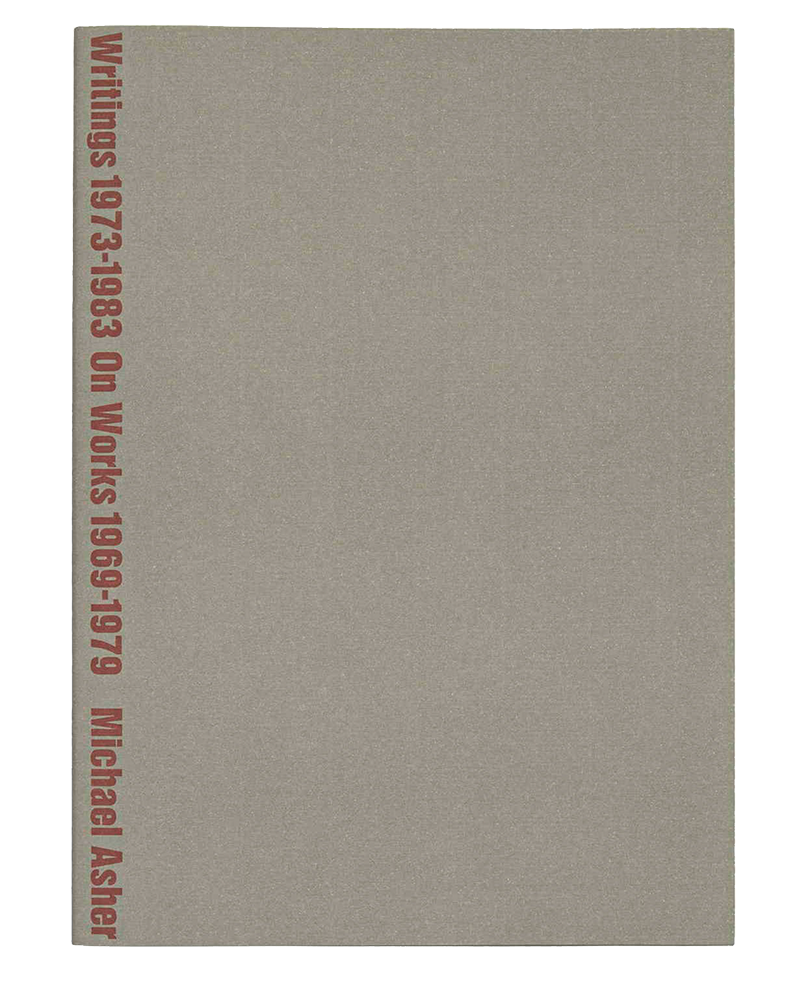 October 2021
October 2021
New Edition of Writings 1973-1983 on Works 1969-1979
Michael Asher Foundation is pleased to announce the release of a new edition of Michael Asher’s Writings 1973–1983 on Works 1969–1979, published by Primary Information and available October 2021.
Writings 1973–1983 on Works 1969–1979 thoroughly documents thirty-three works over a ten-year period early in the artist’s career. The book was originally copublished in 1983 by The Press of the Nova Scotia College of Art and Design (NSCAD) and The Museum of Contemporary Art, Los Angeles (MOCA), with editor Benjamin H.D. Buchloh working in close collaboration with the artist.
This 2021 facsimile edition is based on a special version of the 1983 book that features documentation, on the inside of the dust jacket, of a work by Asher for MOCA’s In Context exhibition series (1983–85). It also includes limited corrections to images and captions, following directions that Asher made in case of a possible future edition.

